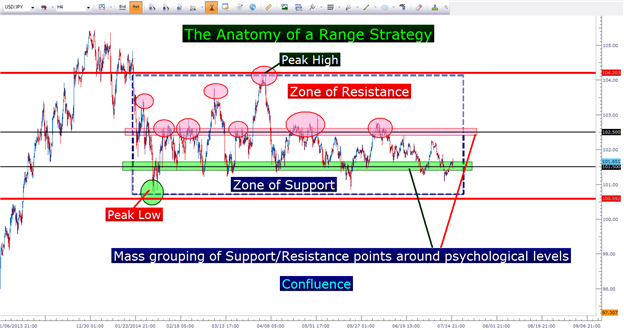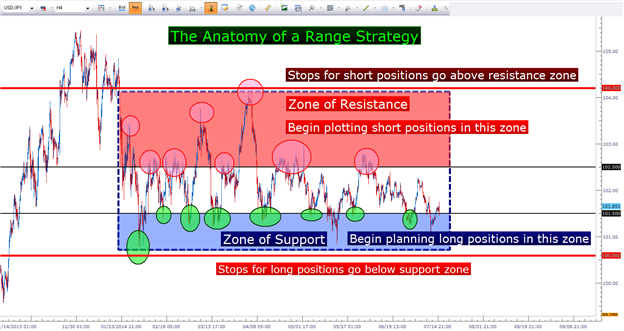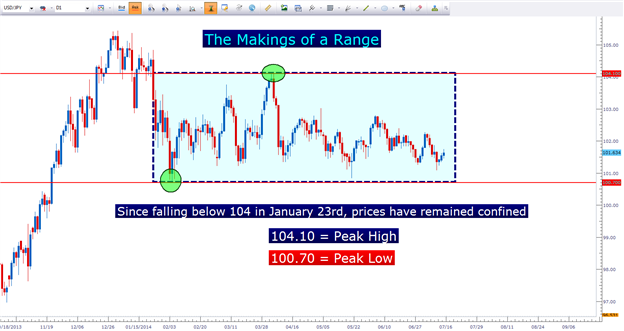The Best Market Environment for Retail Forex Traders
DailyFX.com –
Talking Points:
- This article continues our series on the topic of price action analysis.
- Previously, we had investigated the three different market conditions that will show up in markets.
- In our last article, we looked at trading trends; in this article we investigate ranges.
In our last article, we looked at trading trends with price action analysis. As we explained, the trending market condition is often preferred by traders because of the huge upside potential coupled with the ability to enter positions relatively cheaply (tight stops when trying to catch swings).
But the fact-of-the-matter is that trends are the exception rather than the rule. By most accounts, markets spend a large portion of the time ranging back-and-forth; and depending on who you listen to or which market you trade – this deviation can be more or less pronounced.
But is this a ‘bad’ thing? Many traders run away from range-bound markets as if they’re infected with the plague… but is this market condition one that should be ignored?
In this article, we’re going to do our best to tackle the range. And in our next piece, we’re going to look at the market condition that is exactly the opposite of the range: The Breakout. If you’d like to be notified as this article, along with the rest of our price action series is published, please click on the link below to join my distribution list:
Please click HERE to join my distribution list
Why Traders Should Include a Range-Approach in their Arsenal
Traders should, at the very least, learn to analyze ranges for one big reason: Consistency.
It’s pretty baffling to hear newer traders complain about a lack of volatility. Volatility is synonymous with risk… so when I hear this, it’s like hearing someone say ‘the market isn’t risky enough.’
Well – make no mistake about it, any market you trade is always bearing risk(s). Perhaps sometimes more than others, but think about this for a moment…
As volatility (risk) increases, so does the unpredictability of price movements. So while everyone in the world might want to trade EURUSD during NFP, the fact-of-the-matter is that it’s not likely to be a high-probability play.
Further to that point – those high-risk periods in the markets can make it extremely difficult to manage risk. Your stops will get hit quicker, prices will reverse faster than normal; and if you’re bold enough to go into a news trade without a stop: Good luck, because you can watch 50% of your equity go up-in-smoke quicker than Janet Yellen can shout ‘more QE!’
The range is more calm, more consistent, and all-in-all usually a more comfortable way to manage risks. But you don’t have to take my word for it… this was a central tenet of the DailyFX Traits of Successful Traders research.
We originally wanted to see which trading session was best for retail traders, so David Rodriguez ran profitability statistics for retail traders based on time-of-day. The deviation was very pronounced, as the Asian trading session was far-and-away the most profitable time-of-day for retail FX Traders.
The deviation was so pronounced that we wanted to find out why…
So, David then looked at volatility levels during each of these trading sessions, and this is where the deviation began to make sense.
Volatility, in general, is lower during the Asian trading session. This means that price movements are, in general, smaller coupled along with a higher degree of respect for support and resistance.
Higher-volatility periods such as the European session or the US session saw far less profitability amongst retail traders; and one of the primary reasons is because of the higher levels of volatility brought on by news releases and data announcements made these speculators even more vulnerable to The Number One Mistake that Forex Traders Make.
So, if a trader enters a trade and places a stop for a long position underneath support (or stop for shorts above resistance) – this means that the trader can have a greater chance of seeing the stop respected in a lower-volatility environment, like a range.
But does this mean that all traders should stop what they’re doing to re-build their trading plans so that they can focus on range-bound markets during the Asian trading session? Absolutely not… this merely means that traders should have a way of trading range-bound markets because it can be a more amenable environment, especially for newer retail traders that lack the experience to be consistently profitable during the ‘manic’ times in the market. This is simply another arrow to add in your quiver.
If you want to see the full research series, you can visit the capstone for Traits of Successful Traders at the link below:
Link for Traits of Successful Traders
How to Trade Ranges
Just as any of the three conditions, there are quite a few ways to go about speculating in that environment.
The basis of a range-approach is support and resistance – and the ability to see prices move between those two boundaries.
This support and resistance can come into the market from a variety of ways. We spent an entire month’s worth of articles on the topic of Support and Resistance in June, and if you’d like to access the ‘capstone (covers each of the topics with links to the individual articles), you can certainly access that from the link below:
The Forex Trader’s Guide to Support and Resistance
As we explained in the Support and Resistance series, it isn’t enough to simply identify the price level and say ‘well that’s support,’ or ‘that is resistance.’ To ‘validate’ the level, traders want to see an actual reaction taking place around that price.
This is the great part about price action: It isn’t esoteric, nor is it ‘theoretical.’ Price action is simply noticing that buyers had entered the market at a certain price – thereby ‘supporting’ that market at that price level – or the fact that sellers had come in as a new, higher prices were offered, thereby ‘resisting’ in that market.
There’s an excellent example of a range right now in USDJPY. Since dropping below 104 on January 23rd of this year, the pair has been caught between support and resistance. The chart below is the daily chart in USDJPY, with the range annotated:
The Current Range in USDJPY (Daily Chart)
Created with Marketscope/Trading Station II; prepared by James Stanley
Notice how after establishing support at 100.70, the pair has stayed confined between this price level and resistance of 104.10 for well over five months; continuing to oscillate between support and resistance.
We can also notice how traders weren’t quite willing to wait for prices to move all the way down to 100.70 before buying, or up to 104.10 before selling… quite a bit of support and resistance took place slightly inside of each of these levels; making support and resistance more of a ‘zone’ as opposed to a hard-set-and-fast horizontal price level.
Also notice how much of this support or resistance inside of these ‘peak’ levels showed up around psychological support and resistance. This is the power of confluence showing itself in this range of USDJPY.
After filling in the ‘zones’ of support and resistance, we can begin moving a step closer to an actual strategy for trading around this range:
Price Action can help to show Support/Resistance as a ‘Zone’ – USDJPY 4-Hour Chart

Created with Marketscope/Trading Station II; prepared by James Stanley
This is the Reason that Ranges can be So Beneficial to Traders
After we’ve added our zones, we can then decide how, when, and where we want to look to buy and sell. And the best part about the range – there is no guesswork. The below image shows how traders can build a strategy based on what we’ve already looked at:
Building a strategy for trading the range (USDJPY 4-Hour Chart)

Created with Marketscope/Trading Station II; prepared by James Stanley
Because support and resistance has been confined between 100.70 and 104.10 – we know that if prices breakout of that range, then the environment that we’re looking to speculate in (the range) is no longer valid.
So why would we want to sit in a short position while USDJPY rips up to new highs at 106 or 107? We wouldn’t!
Or further – if USDJPY breaks below 100.70 – would we really want to be sitting in a long position with the expectation that the range might come back even though prices have broken out to the downside?
The best part about trading the range is that risk is always defined. This doesn’t mean that prices can’t break support or resistance only to see prices come back into the range-bound patterns… but it does mean if you see a break, you can have a level of confidence in closing out the trade in an effort to avoid losing more than absolutely necessary.
Further to that point – there is no guesswork with profit targets. If you’re trading a range and you bought when price was at support and price is now at resistance – you can, once again, take a degree of confidence into the act of closing out the position.
So while trends have the constant question of whether or not we’ve hit the ‘higher low ‘or‘ lower high,’ and breakouts are constantly bombarded with questions of legitimacy, the range can be expected to continue until something changes. The luxury of having a defined-risk profile in the strategy makes the condition even more attractive; and if you combine that with the fact that range-bound markets are the most common condition – having a mannerism of attacking the range becomes a very sensible fact.
In Conclusion
Hopefully this article helped to excite, or perhaps even just to attract you to trading range-bound market conditions.
I think that I know why ranges are so unattractive to traders, especially new ones; and I haven’t mentioned that up until now because I wanted to close this article with a quote…
Most traders avoid ranges because they can be seen as ‘boring.’ Many traders jump into markets during heavy volatility, high news and data-flow type of environments. One look at the new volume indicator from FXCM will show you just how pronounced this increase in interest and activity can be.
The idea of fast movements in prices brings on the idea of fast profits. It’s only with time and experience that one learns that there is no such thing as fast profits in any market. There’s only risk and more risk. So while heavier risk might bring the potential of higher returns, there’s also a smaller chance of you getting there.
And to close this article, I wanted to share with you a quote from the book Market Wizards with Jack Schwager, in which he interviewed one of the living-legends in the field of trading:
‘Win or Lose, everybody gets what they want out of markets. Some people seem to like to lose, so they win by losing money.‘ – Mr. Ed Seykota
The follow-up question from that comment is whether you want excitement (trading news and heavy volatility), or assuredness in your trade setups?
All of this is not to say that trends or breakouts cannot be traded; we showed you how to trade trends in our last article and we’ll look at how to trade breakouts in our next. But this needs to be done with upmost of caution because the same level of consistency that can be seen in ranges is not commonly available in alternative environments.
— Written by James Stanley
Before employing any of the mentioned methods, traders should first test on a demo account. The demo account is free; features live prices, and can be a phenomenal testing ground for new strategies and methods. Click here to sign up for a free demo account through FXCM.
James is available on Twitter @JStanleyFX
Are you looking to take your trading to the next level? The DailyFX 360° Course offers a full curriculum, along with private, weekly webinars in which we walk traders through dynamic market conditions using the education taught in the course.
If you’d like a customized curriculum based on your current experience level, our Trader IQ course via Brainshark can offer assistance. Please click on the link below to complete our Trader IQ questionnaire.
Would you like to trade alongside seasoned professionals throughout the trading day? DailyFX On Demand gives you access to DailyFX Analysts during the most active periods of the trading day.
Would you like to enhance your FX Education? DailyFX has recently launched DailyFX University; which is completely free to any and all traders!
Source: The Best Market Environment for Retail Forex Traders






